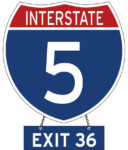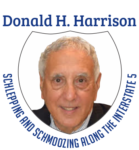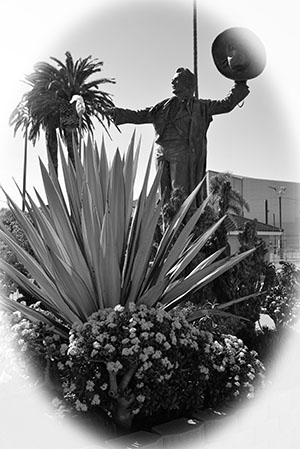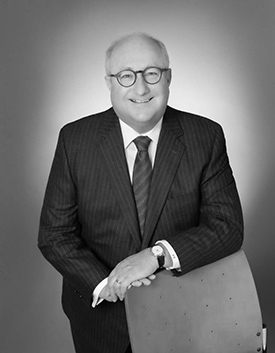 Editor’s Note: This is the 30th and final chapter in Volume 2 of Editor Emeritus Donald H. Harrison’s 2022 trilogy, “Schlepping and Schmoozing Along the Interstate 5.” All three books as well as others written by Harrison may be purchased from Amazon.com.
Editor’s Note: This is the 30th and final chapter in Volume 2 of Editor Emeritus Donald H. Harrison’s 2022 trilogy, “Schlepping and Schmoozing Along the Interstate 5.” All three books as well as others written by Harrison may be purchased from Amazon.com.
Schlepping and Schmoozing Along the Interstate 5, Volume 2, Exit 36(Via de la Valle): San Diego County Fairgrounds
From northbound Interstate 5, take the Via de la Valle exit. Turn left (west) on Via de la Valle to another left at Jimmy Durante Boulevard, and follow to the entrance of the Fairgrounds on the right. Address is 2260 Jimmy Durante Boulevard.


DEL MAR, California — Even before California became a state, San Diego County was widely known for the abundance of its livestock. In 1835, Richard Henry Dana visited San Diego during a nautical adventure described in his memoir Two Years Before the Mast. He told of the hide houses inside San Diego Bay where sailors could purchase stacks of cowhides to be taken to the East Cast to be tanned into leather goods. So abundant were these hides, and so often were they used in trade for other goods, they became known popularly as California dollars.
Slightly more than a century later, California created a series of agricultural districts running up and down the state to promote the production of crops and livestock. San Diego County became coterminous with the 22nd District Agricultural Association. Similar to the rest of the counties throughout the state, it holds a county fair once a year – in June – with a major purpose being to permit livestock breeders to show off their prize animals and to sell them at auction.
Situated on the 340-acre Del Mar Fairgrounds (also called the San Diego County Fairgrounds), the county fair took on another dimension over the years. It became a carnival with exciting rides and exotic foods to sample, and a place for manufacturers to introduce their latest inventions and gizmos. There were exhibits of varied collections, ranging from art works to clothing patches, license plates, playing cards, pennants, and ceramics; concerts and musical performances throughout the grounds; walk-about entertainers; and themed educational exhibits ranging from explorations of humanity’s probes into space to a celebration of the music of the Beatles.
Throughout its entire history, the San Diego County Fairgrounds—which leases space to the Del Mar Thoroughbred Club for its season of horseracing “where the surf meets the turf” – has featured encounters between humans and animals, sometimes endearing and sometimes controversial.
Frederick Schenk had served nearly three complete terms as a member of the 22nd Agricultural Association board when I interviewed him in December 2021. A Democrat, he has been appointed by two Democratic governors to serve on the nine-member board. Gov. Gray Davis originally appointed him to fill the unexpired term of Alex Szekely, who died in office. Szekely was a Jewish community member whose mother, Deborah Szekely, had founded Rancho La Puerta in nearby Tecate, Mexico, as well as the Golden Door Spa in Escondido.
Rather than reappoint Schenk, Republican Gov. Arnold Schwarzenegger chose his own candidate for a four-year term. Later Gov Jerry Brown appointed Schenk to a new term and subsequently reappointed him. Altogether, Schenk had served 11 years and was waiting to learn whether Gov. Gavin Newsom would reappoint him in 2022. [DHH-Newsom did reappoint him] Schenk served for 2 ½ years as the board’s president. Previously Schenk, who is an attorney, had served as a president of the Lawrence Family Jewish Community Center.

Schenk told me that he was introduced to the San Diego County Fair in the 1990s when his brother in-law Hugh Friedman (an attorney married to Schenk’s sister, Lynn Schenk, who was later elected to Congress) served on the board. “I was living in Los Angeles, and I wanted to come down in the summer to visit Lynn and Hugh,” he reminisced. “I would pick the time frame of the Fair to come and visit, and I fell in love with all that it represented. It brought the community together. It was a fun and educational experience. I loved going into the barn area and seeing animals that I rarely got to see – watching the new mothers, the cows, being milked and feeding their babies. I just enjoyed that whole experience.”
Schenk noted that, “There is a small but vocal community opposing the animals on the property and having livestock on the property and the sale of livestock. Our mission statement is about making the fairgrounds an agricultural environment. We are part of the California Department of Food and Agriculture. So, those who would take exception to our mission statement are the ones who would say, ‘well you know, you shouldn’t have young people selling their livestock.’ Well they are the Future Farmers of America (FFA) and members of 4-H and that is the world in which they want to spend their career, or their hobbies, and that is what their circle of life is all about – animal husbandry. It’s about livestock. So, yes, we do have an auction at the end of the Fair but that is a vital part of what we have done for decades and decades.”
Schenk said that “there are 53 state fairs; it is within our state constitution. The original fair notion came about during the harvest season when farmers would come together to sell their crops. It promoted business opportunities for farmers and merchants and for the community in the area to come and purchase crops and livestock, California being a very major agricultural state.”
Animals shown and judged during the Fair include poultry, swine, lambs, steers, goats, and rabbits. At the end of the Fair, some animals not already sold are auctioned, with some proceeds underwriting the Don Diego Scholarship Foundation.
That, explains Schenk, “is a nonprofit foundation that has given away over $1 million to high school graduates who are going into college and trade. The single requirement for any of these candidates, besides an extensive interviewing process, is that they either work on the property or they showed livestock on the property at some time during their youth So, either they were involved in agriculture or livestock, showing their animals, or they worked on the property during the Fair – working at a food stall or working in whatever capacity that we hire youth, and we do. That qualifies these young men and women to apply for scholarships, which are between $2,500 and $10,000. For more than ten years, I have served as the auctioneer at the live auction where we have raised tens of thousands of dollars and all that money goes for scholarships.”
Schenk said during his tenure as the Fair board’s president, “We added a section of the Fair where children could have an experiential opportunity to learn about farming, organic farming, and how to grow crops. We go to lower economic communities and teach children about growing vegetables and giving them the opportunity to come to the fairgrounds on school buses. We show them, for example, how to grow a radish, and then their radishes are planted, and they can watch them grown on the fairgrounds’ property. But it also gives them an opportunity to experience the Fair, learn about livestock, and learn about agriculture because we think every child should know about that. This is where California started and it is an important part of our economy.”
While Schenk favors continued exhibition of traditional livestock animals, he and fellow board members voted to end elephant rides which had been featured at the Fair for several decades. While “they didn’t reflect what we thought was a nurturing environment for those animals,” he said, his main reason for voting to terminate the rides was that “it didn’t meet with the purpose and intent of what we do. Horses certainly are part of our agricultural process. Horses are used in a lot of different ways for agriculture. We have a horse park (east of the Interstate 5) where we have dressage and different types of horse shows. Across the street, on city property, they have polo. We are part of the California Department of Food and Agriculture. Horses, pigs, chickens, sheep, cows are all under that. Elephants are not part of that.”
That decision prompted People for the Ethical Treatment of Animals (PETA) to issue a statement in March 2014 saying the organization was “popping champagne corks today to celebrate the news that Have Trunk Will Travel (HTWT) will not offer cruel and unsafe elephant rides at this year’s San Diego County Fair. HTWT, which has provided the rides for years, has been caught on video beating elephants with sharp metal-tipped bull hooks and shocking them with electric prods. When not forced to perform under the threat of punishment, the elephants with HTWT spend the majority of their lives chained so tightly that they can take only a single step in any direction. PETA encourages people never to attend a circus, fair, or other event where elephants are forced to perform.”
Thoroughbred horses are featured during the summer racing season of the Del Mar Thoroughbred Club, which as a lessee has a separate board of directors. There have been numerous instances over the years of horses dying at California racetracks including Del Mar, which has prompted calls from groups like PETA for an end to horseracing.
For example in September 2015, PETA demanded that law enforcement officials “launch an investigation into the deaths of as many as 13 Thoroughbred horses in just the first few weeks of the Del Mar racetrack’s summer meet. Since July 19, ten Thoroughbreds broke bones and were destroyed, and three other horses died or were euthanized the week before the meet opened. Additionally, the fates of two horses, Sinfully and Divine Tale, who were injured on the track on August 27 and 20, are unknown. PETA believes that all the horses may have had undisclosed injuries that were masked by medications commonly administered to keep lame and unfit horses competing – and that racing injured horses may violate state anti-cruelty laws.”
In November 2019, following the death of a horse named Koa at the del Mar Race Track, Peta Senior Vice President Kathy Guillermo issued the following statement: “California tracks have been littered with the bodies of horses trained by Jerry Hollendorfer, who was barred from Santa Anita but prevented from being banned at Del Mar by a San Diego County court. The California Horse Racing Board needs to suspend his license now. He leaves a bloody trail, with four of his horses dead at Santa Anita Park, two at Golden Gate Fields, and now one at Del Mar in just the last year. PETA is calling on the San Diego district attorney to open a investigation into the training and veterinary methods immediately. Hollendorfer had six chances too many in 2019.”
Prior to 2019, two other horses trained by Hollendorfer had died at Del Mar while racing: Longview Drive in 2014 and Urloveneverfails in 2015.
The San Diego County Democratic Party in October 2021 adopted a resolution calling for a ban on state-sponsored horse racing. Lori Saldaña, a member of that committee who previously served in the state Assembly, commented that attitudes about animal competitions have changed over the years: “We don’t do dogfighting, we don’t do cockfighting; we don’t do bullfighting,” she said. The resolution would not impact private horseracing without state-sanctioned gambling.
Following the collapse and death of Kentucky Derby winner Medina Spirit during a workout at the Santa Anita racetrack in December 2021, U.S. Sen Dianne Feinstein (D-California) demanded a thorough investigation into equine deaths. In a letter to the California Horse Racing Board, she said Medina Spirit “is one of 71 racehorses who have died at California racing facilities thus far in 2021. While this represents a reduction in deaths from prior years, it is apparent that more work is necessary to prevent these tragic fatalities.”
Joe Harper, chief executive officer of the Del Mar Thoroughbred Club, issued a statement in 2021 saying that his organization “is committed to the industry’s most progressive safety and welfare protocols and has taken great strides in recent years to implement a number of additional procedures intended to make racing at Del Mar safer, including:
*Enhancing pre-race veterinarian inspections, stable security, and increasing out-of-competition testing.
*Revising training protocols including additional veterinarians to oversee workouts.
*Restrictive use of riding crops during morning workouts and continuing enforcement of the most restrictive rules in North America regarding the riding crop in racing.
*Independent review panel consisting of California Horse Racing Board veterinarians and experts that oversee race entries.
“We’re happy to report those changes contributed to Del Mar continuing to be the safest racetrack in the country for the third year in a row – according to statistics gathered by the Jockey Club – with more than 99 percent of racing conducted safely,” Harper said.
“We believe there are even more opportunities for continued improvement,” he added. “To that end Del Mar is a founding member of the Thoroughbred Safety Coalition, which is pushing for implementation of comprehensive and centralized standards. Addressing our industry’s safety challenges requires concrete action – with medical and operational reforms, including enhanced transparency and improved information sharing. More must be done, this is just the start.”
“Building on the positive results of the past three seasons, we believe these enhancements will make racing at Del Mar even safer for both our equine and human athletes.”
Schenk shares Harper’s pride in the Del Mar Racetrack’s safety record. He describes the opponents of horseracing as a “small minority” who “have the right to have their voice heard but don’t have the right to carry the day when a majority of the people support this type of gaming.” He noted that based on revenues, horseracing is growing in popularity. In 2021, revenues from horseracing at Del Mar were $11.29 million and were projected to go up in the 2022 season.
Furthermore, he said, “horseracing is responsible for 23,000 jobs and has a $2.5 billion impact to the state.”
Another controversy erupted at the fairgrounds in June 2019. The death of a 2-year-old Jedediah Cabezuela and the sickening of three other children, ages 9, 11, and 13, from E Coli prompted the closing of the animal exhibits and the petting zoo. Although animal pens are cleaned before and after the fair, as well as daily, it is possible that animals will lay down in the straw and come into contact with their own feces. If children hug the animals and later put their fingers in their mouths, E Coli can be transmitted. The fairground has installed washing stations near the animal exhibits along with signs that urge people to wash with soap and water after touching animals.
Schenk said during our interview that he could not discuss the ensuing litigation, but could comment generally about the need for adults to be vigilant in making certain that children who come into contact keep their fingers out of their mouths and use the soap and water the fair provides after visiting the animals.
“E Coli is not the product of an animal being sick,” he said. “It is about the waste that they create. This is an agricultural facility. We post signs and provide soap and water and towels for every person who walks in and out. We admonish people about not eating in the facility. Not putting food in their mouths. We put up signs, provide products for hygiene.” It is unfortunate, he said, that not everyone heeds those signs, which are posted in both English and Spanish.
*
Donald H. Harrison is editor emeritus of San Diego Jewish World. He may be contacted via donald.harrison@sdjewishworld.com